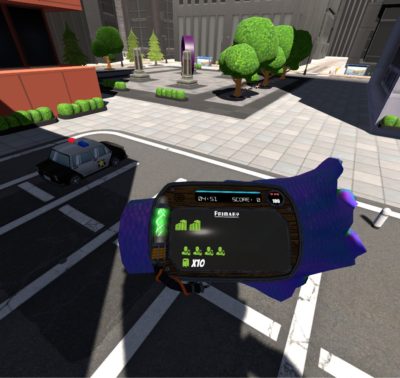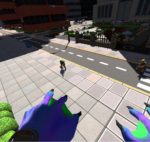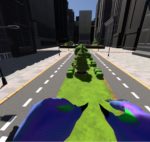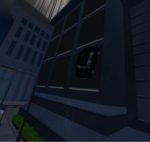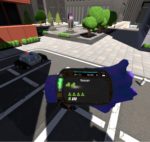Developer/Publisher: QuantumSquid Interactive || Overall: 3/10
Yeah, a 3/10. I don’t usually have to go that low because I have the good luck of playing games I can enjoy. Pylon: Rogue is probably one of the more frustrating experiences I’ve had this year. When the potential for fun is there, but you are cockblocked by unrelenting difficulty, it’s impossible to enjoy anything. I can’t enjoy it. There’s no way. I’ve spent almost three hours wiping; most runs only last about five minutes, and one or two lasted maybe fifteen minutes. I suppose Pylon: Rogue isn’t really that shitty, but it’s just a victim of its own balance issues and an extremely stingy reward system.
As a 3D roguelike action game, at first glance it might seem Diablo-esque. However, it’s a single-button-combo beat-em-up game where you might sometimes come across some buffs before you die. There’s no overworld, either, as you start out on a level selection board with no free-roaming — often you’re forced to only go one way. Once you select a level, you’ll trudge through a number of rooms, ranging from about three to nine, and hopefully the “Exit” will spawn after clearing one, at which point you can go back to the level selection board. If the Exit pops and you take it, you forfeit your chance to go through the rest of the rooms and potentially pick up more money/gear, though you’re more likely to just die. Each “Room” can have up to three waves of enemies and depending on how well you can smash buttons and dodge enemy attacks, you’ll take damage and die or succeed and go to the next level. If you stick around in a level after the Exit pops, you can clear all of the rooms and unlock a final bonus chest. In the end, the overall goal here is to beat four levels, reach the boss of the area and defeat them. Unlike your typical roguelike, there doesn’t seem to be any procedural generation, so after a number of wipes you’ll see all of the different level layouts.
Technically this all sounds fine, but the reward system is completely fucked. They throw you into the fire as soon as you start out — forget having any tools to prepare you. They don’t start you with seed money to allow modification of your spec in a different way at the shop, nor do they give you many opportunities to heal damage you will inevitably take tons of. Three of the four classes are melee and each have three different weapon specs. From there, you’ll gain your roguelike buffs, though they are curiously very scarce. Since most of the classes are melee, you will always take damage as you get up close to enemies; this exposes a significant flaw in the game design: there is a lack of healing mechanics to make any of this a fair fight. If you get lucky, a health drop will appear, though usually only for 50 points, at most 25% of your health bar depending on your class. Considering you can lose that much in two hits, they don’t drop nearly often enough and you’ll almost always come out behind after clearing a room. There is no guarantee a health drop will ever appear, as it is random.
Clearing rooms often gets you a very low amount of the “Gem” currency. By the time you leave a level you could have around 200 or 300 Gems, but you’ll probably just waste all of it on buying health at the shop. Most gear costs anywhere from 200 to 400 by itself, so good luck using that new piece of equipment to any effective order when you have 10% health left. There’s plenty of other issues, all revolving around “balance.” At the onset of a new run, your character feels much too weak, or in other words, the enemies take too long to kill. Early on in a run we should be able to defeat most monsters with one or two hits, except it takes upwards of three to five. Your enemies also hit like a truck and you’ll lose 15 to 20% of your health for one unavoidable hit. There should have been some sort of stagger mechanic where if you hit an enemy it resets their attack swing and avoid potential damage — Hand of Fate does this and the action sequences between the two titles are generally very similar. Spells that your enemies cast are nearly all instant and you often aren’t allowed the opportunity to move out. For example, there is a lightning spell which will cast as a circle on the ground, and the only way to avoid damage is moving out within the first second. Projectile spells are a bit easier to avoid, but if you are in melee range there’s not much you can do to avoid it other than constantly run around. Defensive spells either are cooldown or charge-based, and often take time to actually react to any incoming damage, so it can often be more fruitful to run around like an idiot.
There are a few things the game gets right. There are four classes with three different specs each, and they all play appreciably different. You do have to unlock a majority of the extra specs depending on certain conditions so there is some longevity in what they offer you at first. The single-button-combo system is fine and has some depth to it, though I prefer multi-button combo systems. You can hold X after any number of button presses, allowing you to perform one of the four special “charge attacks.” Finally, each character has a unique special ability that can only be used as many times as you have “scrolls,” at a maximum of four. If a scroll drops and you’re at four, it’s basically wasted. This isn’t awful in and of itself, in fact it could be nice to be able to make the decision to use your fourth scroll more liberally so you don’t lose out on a charge.
In the end, I think the biggest killer for Pylon: Rogue is that the rewards suck. Most of the rewards you are earning aren’t even gear/powerups, it’s currency. Currency you can’t even use until you exit the level; most of the time you’re going to die before getting the opportunity to visit the shop, or in the event you do get out of a level, you’ll waste it on health. There should have been way more gear/powerups dropping from chests that spawn. Chests will only spawn once you clear a room, and currently it feels about 10% of the chests will have gear in it. The rest of the time you’ll get a pittance of gems which will not help you get through the level you are currently stuck in. The percentage should feel at minimum around 50% for your first level so that you can gain a footing in a new run and make more interesting decisions at at a later point in the gameplay loop rather than having most of your wipes in the less than ten minute range.
So, Pylon: Rogue is a game that will boot up and responds to your controller commands. It works, you can play it, but unless you’re some savant in the genre you aren’t getting anything out of this game farther than a couple of levels, if that. There was some hope of a balance patch but the time frame for that came and went and the patch that did drop didn’t make anything easier. The balance is so off here that we’ve sunk into the ocean. I’ve already succumbed to the sweetness of death, filling my lungs with water, and air costs more Gems than what I have to spend. Why are they selling air at the bottom of the ocean? You got me.





































































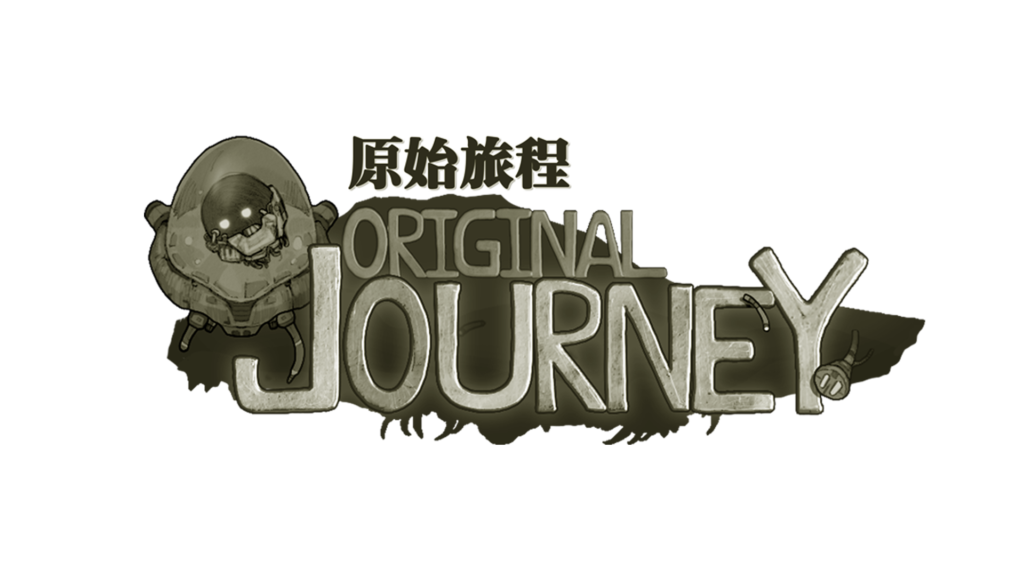
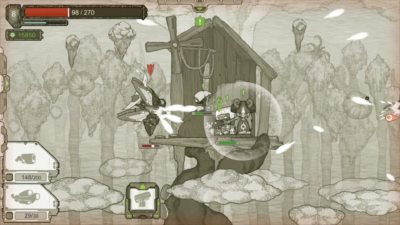 Alright, so in Original Journey (“original title do not steal”) you’re a plant thing in an exo suit on a mission with dozens of others to save your planet. For plot device reasons you’re not told why you’re on the planet Shadow (“original name do not steal”) aside from these green crystals, which, incidentally, a vibrant green object in an otherwise monochrome game. These things, you see, heal your folk and planet, or something. I don’t know. Anyway, a bunch more stuff happens that doesn’t even make sense in any context, like you needing to get monster teeth to make a translation program for your droid, or talking to a dude with amnesia that gives you an emerald-looking thing called a Chaos Key (“original concept and name do not steal”) and some schematics only your race could ever utilize. I don’t understand who’s writing this, or if it’s a translation error, but the story really needs, like… a spit shine, at least. It’s rough, and, at points: totally inane.
Alright, so in Original Journey (“original title do not steal”) you’re a plant thing in an exo suit on a mission with dozens of others to save your planet. For plot device reasons you’re not told why you’re on the planet Shadow (“original name do not steal”) aside from these green crystals, which, incidentally, a vibrant green object in an otherwise monochrome game. These things, you see, heal your folk and planet, or something. I don’t know. Anyway, a bunch more stuff happens that doesn’t even make sense in any context, like you needing to get monster teeth to make a translation program for your droid, or talking to a dude with amnesia that gives you an emerald-looking thing called a Chaos Key (“original concept and name do not steal”) and some schematics only your race could ever utilize. I don’t understand who’s writing this, or if it’s a translation error, but the story really needs, like… a spit shine, at least. It’s rough, and, at points: totally inane.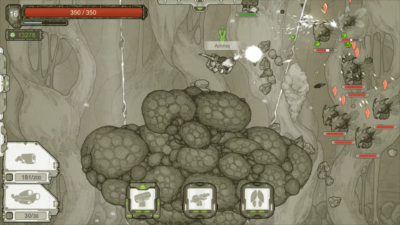 This title’s a sidescroller, and your character’s armament is limited to a suit (with a chip in it; think socketing items in Diablo or Path of Exile), a left weapon and a right weapon. Most of the weapons are guns, but for some reason you have no ability to aim these fucking things. Your vegetable’s aim sways back and forth at approximately an upward 45 degree angle, making anything with less spread than a shotgun annoying to use. Aiming directly at an enemy involves walking right next to them and fucking pulling the trigger. This means that often times, for air enemies, you’re jumping constantly in the air in order to do any good. Weapons have limited ammo, so often times you’ll be wasting most of your ammo trying to knock some bullshit out of the sky. This gets worse later, with enemies hanging out toward the bottom of the goddamn screen. WHY? WHY DO THIS? WHY THE FUCK CAN’T I AIM AT HIM? I HAVE TWO FUCKING GUNS AND I CA-
This title’s a sidescroller, and your character’s armament is limited to a suit (with a chip in it; think socketing items in Diablo or Path of Exile), a left weapon and a right weapon. Most of the weapons are guns, but for some reason you have no ability to aim these fucking things. Your vegetable’s aim sways back and forth at approximately an upward 45 degree angle, making anything with less spread than a shotgun annoying to use. Aiming directly at an enemy involves walking right next to them and fucking pulling the trigger. This means that often times, for air enemies, you’re jumping constantly in the air in order to do any good. Weapons have limited ammo, so often times you’ll be wasting most of your ammo trying to knock some bullshit out of the sky. This gets worse later, with enemies hanging out toward the bottom of the goddamn screen. WHY? WHY DO THIS? WHY THE FUCK CAN’T I AIM AT HIM? I HAVE TWO FUCKING GUNS AND I CA-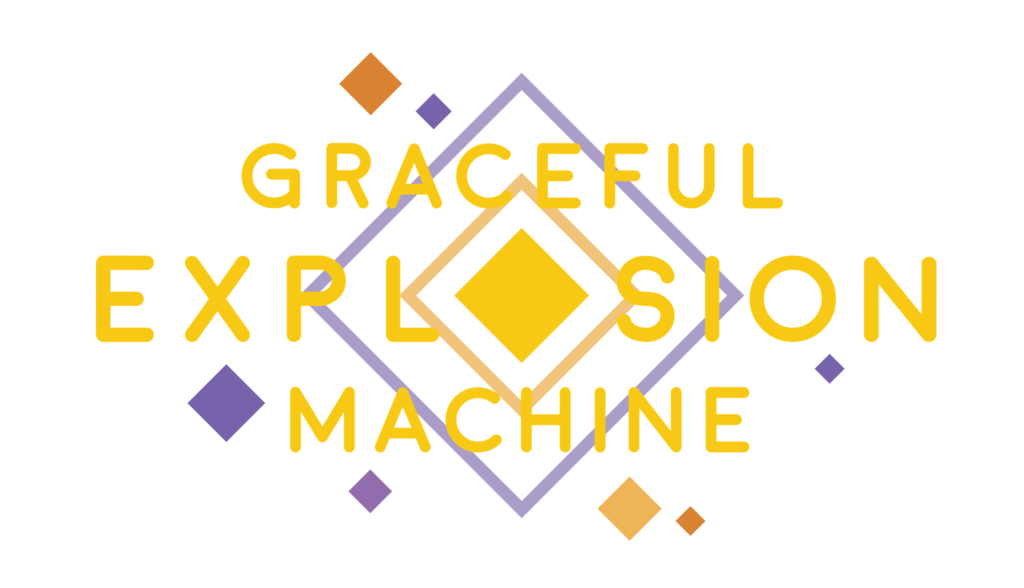
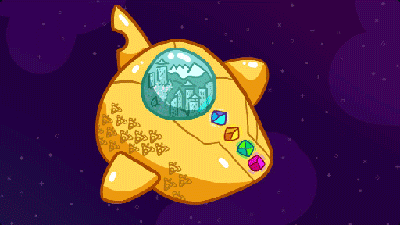
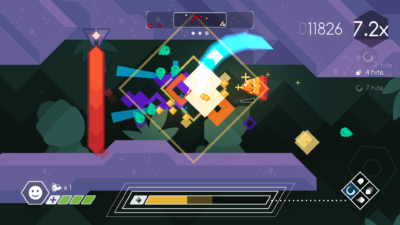 Now, for some reason this ship is unarmed until it picks up conspicuously laid out weapons in the tutorial, which is probably why these yellow guys got their shit ruined in the first place. First you get a pea shooter, which rapidly fires out blasts until it overheats, which is its only constraint. Second weapon, you get an “energy sword” which spins around twice on use, tearing into enemies and destroying enemy bullets. Next is a sniper beam, which is a very powerful beam that does a lot of damage and tears through enemy shields, but forces you to move slowly. The last is a missile barrage that can be directed out of your ship with a directional input before they race off to seek targets. With exception of the regular blaster, all weapons require weapon energy to fire. This is harvested from enemies on death via the yellow crystals they drop. The weapon energy meter doesn’t say what the max is, or how much each crystal is worth, nor is the energy required for attacks displayed anywhere, so it’s more of a fuel meter in that regard. Crystal/weapon power management seems to be the main bottleneck of player skill. Players need to swoop through slain enemies in order to get close enough to collect weapon power, which dictates how often you can use area of effect attacks. Gameplay quickly maxes out as an advanced game of chicken, blowing through enemies to collect weapon power to in turn massacre more enemies. The only real thing that mixes this up is how close enemies spawn, and if there’s an enemy that requires you to use the sniper cannon to kill quickly.
Now, for some reason this ship is unarmed until it picks up conspicuously laid out weapons in the tutorial, which is probably why these yellow guys got their shit ruined in the first place. First you get a pea shooter, which rapidly fires out blasts until it overheats, which is its only constraint. Second weapon, you get an “energy sword” which spins around twice on use, tearing into enemies and destroying enemy bullets. Next is a sniper beam, which is a very powerful beam that does a lot of damage and tears through enemy shields, but forces you to move slowly. The last is a missile barrage that can be directed out of your ship with a directional input before they race off to seek targets. With exception of the regular blaster, all weapons require weapon energy to fire. This is harvested from enemies on death via the yellow crystals they drop. The weapon energy meter doesn’t say what the max is, or how much each crystal is worth, nor is the energy required for attacks displayed anywhere, so it’s more of a fuel meter in that regard. Crystal/weapon power management seems to be the main bottleneck of player skill. Players need to swoop through slain enemies in order to get close enough to collect weapon power, which dictates how often you can use area of effect attacks. Gameplay quickly maxes out as an advanced game of chicken, blowing through enemies to collect weapon power to in turn massacre more enemies. The only real thing that mixes this up is how close enemies spawn, and if there’s an enemy that requires you to use the sniper cannon to kill quickly.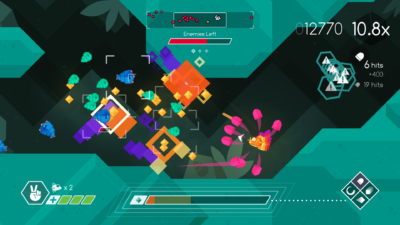 The game is divided into levels on four planets. A few open up for play, unlocking more as you complete them, culminating in a “warp” level to move on to the next planet. Each level has phases, which are this game’s checkpoint system; waves of enemies will spawn throughout an endlessly scrolling cave section as the player kills everything. Points are awarded for each kill, a multiplier in effect for consecutive kills and keeping a spree going. The ship is able to take three hits before dying, but each level has two continues, which can be utilized to restart from the beginning of the last phase that was started. The game isn’t exactly easy, but with tools like these, it’s not difficult either.
The game is divided into levels on four planets. A few open up for play, unlocking more as you complete them, culminating in a “warp” level to move on to the next planet. Each level has phases, which are this game’s checkpoint system; waves of enemies will spawn throughout an endlessly scrolling cave section as the player kills everything. Points are awarded for each kill, a multiplier in effect for consecutive kills and keeping a spree going. The ship is able to take three hits before dying, but each level has two continues, which can be utilized to restart from the beginning of the last phase that was started. The game isn’t exactly easy, but with tools like these, it’s not difficult either.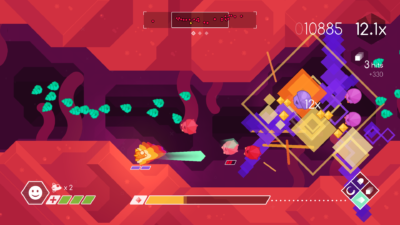 To its credit: the game runs well, and makes use of high refresh rate monitors. The music is benign, but not bad by any means. The controls on keyboard are serviceable, though I recommend controller. What’s more to say about a game that, mechanically, is solid even if there’s no carrot on the stick past score-whoring? There’s nothing particularly wrong with it, but it’s uninspiring, like a joke you’ve heard before, or a monologue on a topic you’re uninterested in.
To its credit: the game runs well, and makes use of high refresh rate monitors. The music is benign, but not bad by any means. The controls on keyboard are serviceable, though I recommend controller. What’s more to say about a game that, mechanically, is solid even if there’s no carrot on the stick past score-whoring? There’s nothing particularly wrong with it, but it’s uninspiring, like a joke you’ve heard before, or a monologue on a topic you’re uninterested in.























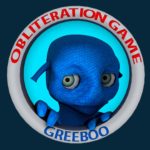



































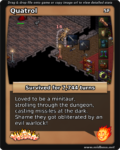




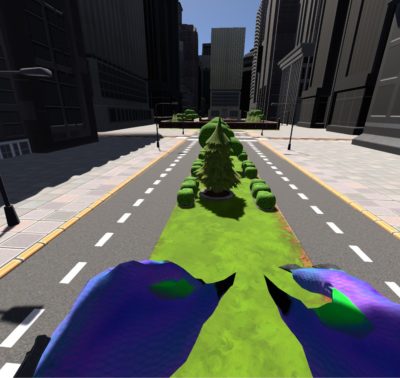 First thing’s first: the unskippable tutorial. You’re not allowed to play the main game or multiplayer without being a big boy and/or girl and playing along with the voiceover’s lesson plan, so I figured I’ll just jump through the hoop. I appear to be a big fishy monster with a big ass watch on my left arm. It’s not super clear from the narration, but from the store page description you can piece together that this annoying dude in your ear is yourself. They teach you how to walk, and then explain some basic monster techniques at your disposal: punching, grabbing, throwing, climbing and jumping.
First thing’s first: the unskippable tutorial. You’re not allowed to play the main game or multiplayer without being a big boy and/or girl and playing along with the voiceover’s lesson plan, so I figured I’ll just jump through the hoop. I appear to be a big fishy monster with a big ass watch on my left arm. It’s not super clear from the narration, but from the store page description you can piece together that this annoying dude in your ear is yourself. They teach you how to walk, and then explain some basic monster techniques at your disposal: punching, grabbing, throwing, climbing and jumping.